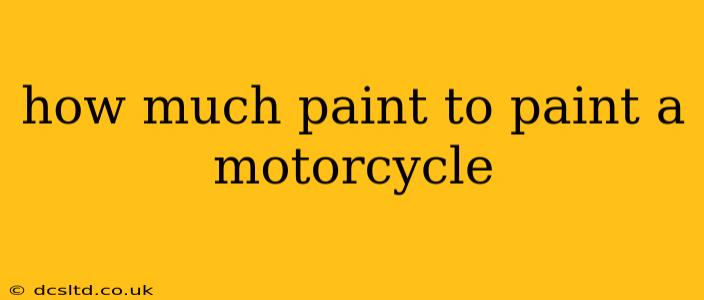How Much Paint to Paint a Motorcycle: A Comprehensive Guide
Painting a motorcycle is a rewarding project, but knowing how much paint to buy is crucial for a successful outcome. Underestimating can lead to color inconsistencies, while overestimating wastes money. This guide will help you accurately calculate the paint needed, considering various factors.
What Factors Determine Paint Quantity?
Several factors influence the amount of paint required for your motorcycle project:
- Motorcycle Size: A smaller motorcycle like a scooter will obviously need less paint than a large touring bike or a custom chopper.
- Number of Coats: Most paint jobs require multiple coats (usually 2-3) for optimal coverage and depth of color. Primer coats are also essential and should be factored into your calculations.
- Paint Type: Different paint types have varying coverage rates. Acrylic lacquer, for example, might need more coats than a high-solids urethane paint.
- Surface Preparation: Thorough surface preparation is critical. Proper cleaning, sanding, and priming ensure better adhesion and reduce paint consumption. A poorly prepped surface might require more paint to achieve even coverage.
- Color: Darker colors generally require more coats than lighter colors to achieve a uniform finish.
How to Estimate Paint Needs: A Step-by-Step Guide
There's no single magic formula, but here's a practical approach:
-
Calculate the Surface Area: This is the most challenging step. While precise measurements are difficult, you can make a reasonable estimate. Consider breaking down your motorcycle into manageable sections (tank, fenders, fairings, etc.) and approximate their surface area using basic geometric shapes (rectangles, circles). Add up the areas of all sections to get a total estimate. Online resources may offer motorcycle-specific surface area calculators, or you can consult a professional painter for a more precise estimation.
-
Consider the Paint Coverage: Check the paint manufacturer's specifications. The coverage rate (typically expressed in square feet per gallon or liter) is crucial. This indicates how much area a single coat of paint will cover.
-
Account for Multiple Coats: Multiply your calculated surface area by the number of coats (primer, color coats, and clear coat if applicable).
-
Add a Safety Margin: Always add 10-20% extra to account for any unforeseen issues like runs, drips, or areas needing extra coats.
-
Calculate the Total Paint Needed: Divide the total surface area (including extra) by the manufacturer’s coverage rate. This will provide the estimated amount of paint required. Always round up to the nearest whole unit (gallon or liter) to avoid running short.
What About Primer and Clear Coat?
Remember to include primer and clear coat in your calculations. They often have different coverage rates than your color coat, so check the manufacturer's specifications for each product. A good primer will improve adhesion and ensure a smooth finish, saving paint in the long run. Clear coat protects your paint job and enhances its shine.
Frequently Asked Questions (FAQs)
Q: Can I use a paint sprayer to reduce paint waste?
A: Yes, using a paint sprayer is a great way to minimize waste and achieve a more even finish compared to using a brush or roller. However, remember that even sprayers can have some overspray. Still factor in a safety margin.
Q: What type of paint is best for painting a motorcycle?
A: High-quality automotive urethane paints are recommended for motorcycles due to their durability, weather resistance, and beautiful finish. Acrylic lacquer is another option, but it's generally less durable.
Q: How much does it cost to paint a motorcycle?
A: The cost varies greatly depending on the paint type, preparation work, and whether you do it yourself or hire a professional. Factor in the cost of paint, sandpaper, primer, clear coat, masking materials, and any necessary tools. Professional painting services can be quite expensive.
Q: How long does it take to paint a motorcycle?
A: The time required depends on the complexity of the motorcycle, the number of coats, and your experience. Allow ample time for proper preparation, each coat to dry completely, and for any necessary sanding between coats.
By following this step-by-step approach and considering the FAQs, you can accurately estimate the amount of paint needed for your motorcycle painting project. Remember, proper planning and preparation are key to a successful and visually stunning result.
